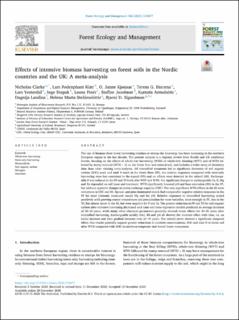| dc.contributor.author | Clarke, Nicholas | |
| dc.contributor.author | Kiær, Lars Pødenphant | |
| dc.contributor.author | Kjønaas, O. Janne | |
| dc.contributor.author | Bárcena, Teresa G. | |
| dc.contributor.author | Vesterdal, Lars | |
| dc.contributor.author | Stupak, Inge | |
| dc.contributor.author | Finér, Leena | |
| dc.contributor.author | Jacobson, Staffan | |
| dc.contributor.author | Armolaitis, Kestutis | |
| dc.contributor.author | Lazdina, Dagnija | |
| dc.contributor.author | Stefánsdóttir, Helena Marta | |
| dc.contributor.author | Sigurdsson, Bjarni D. | |
| dc.date.accessioned | 2021-06-24T14:35:28Z | |
| dc.date.available | 2021-06-24T14:35:28Z | |
| dc.date.created | 2021-01-04T07:15:14Z | |
| dc.date.issued | 2021-02-15 | |
| dc.identifier.citation | Forest Ecology and Management. 2021, 482 . | en_US |
| dc.identifier.issn | 0378-1127 | |
| dc.identifier.uri | https://hdl.handle.net/11250/2761203 | |
| dc.description.abstract | The use of biomass from forest harvesting residues or stumps for bioenergy has been increasing in the northern European region in the last decade. The present analysis is a regional review from Nordic and UK coniferous forests, focusing on the effects of whole-tree harvesting (WTH) or whole-tree thinning (WTT) and of WTH followed by stump removal (WTH + S) on the forest floor and mineral soil, and includes a wider array of chemistry data than other existing meta-analyses. All intensified treaments led to significant decreases of soil organic carbon (SOC) stock and total N stock in the forest floor (FF), but relative responses compared with stem-only harvesting were less consistent in the topsoil (TS) and no effects were detected in the subsoil (SS). Exchangeable P was reduced in the FF and TS both after WTT and WTH, but significant changes in exchangeable Ca, K, Mg and Zn depended on soil layer and treatment. WTH significantly lowered pH and base saturation (BS) in the FF, but without apparent changes in cation exchange capacity (CEC). The only significant WTH-effects in the SS were reductions in CEC and BS. Spruce- and pine-dominated stands had comparable negative relative responses in the FF for most elements measured except Mg and for pH. Relative responses to intensified harvesting scaled positively with growing season temperature and precipitation for most variables, most strongly in FF, less in the TS, but almost never in the SS, but were negative for P and Al. The greater reduction in FF and TS for soil organic carbon after intensive harvesting decreased with time and meta-regression models predicted an average duration of 20–30 years, while many other chemical parameters generally showed linear effects for 30–45 years after intensified harvesting. Exchangeable acidity (EA), BS and pH all showed the reversed effect with time, i.e. an initial increase and then gradual decrease over 24–45 years. The subsoil never showed a significant temporal effect. Our results generally support greater reductions in nutrient concentrations, SOC and total N in forest soil after WTH compared with SOH in northern temperate and boreal forest ecosystems. | en_US |
| dc.language.iso | eng | en_US |
| dc.publisher | Elsevier B.V. | en_US |
| dc.rights | Navngivelse 4.0 Internasjonal | * |
| dc.rights.uri | http://creativecommons.org/licenses/by/4.0/deed.no | * |
| dc.title | Effects of intensive biomass harvesting on forest soils in the Nordic countries and the UK: A meta-analysis | en_US |
| dc.type | Peer reviewed | en_US |
| dc.type | Journal article | en_US |
| dc.description.version | publishedVersion | en_US |
| dc.rights.holder | © 2020 The Author(s) | en_US |
| dc.source.pagenumber | 12 | en_US |
| dc.source.volume | 482 | en_US |
| dc.source.journal | Forest Ecology and Management | en_US |
| dc.identifier.doi | 10.1016/j.foreco.2020.118877 | |
| dc.identifier.cristin | 1864489 | |
| dc.relation.project | Nordisk ministerråd: SNS-118 | en_US |
| dc.relation.project | Norges forskningsråd: 193817 | en_US |
| dc.relation.project | Norges forskningsråd: 233640 | en_US |
| dc.source.articlenumber | 118877 | en_US |
| cristin.ispublished | true | |
| cristin.fulltext | original | |
| cristin.qualitycode | 2 | |

